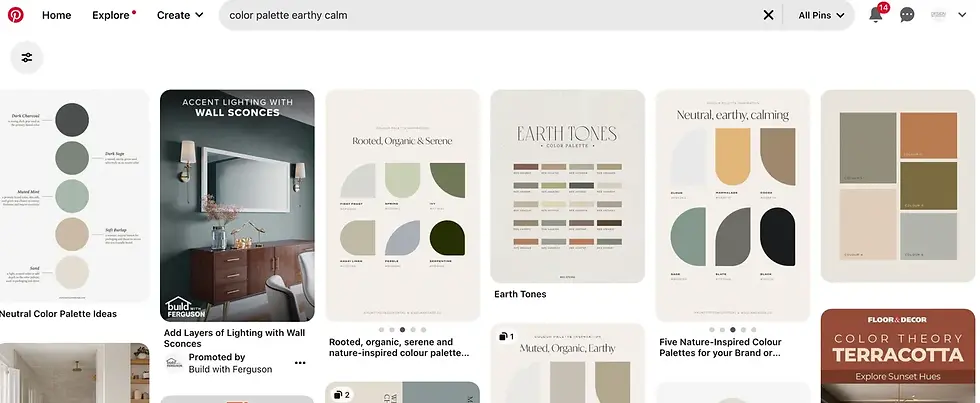HOW TO CHOOSE A COLOR PALETTE FOR YOUR HOME: 5 PRACTICAL STEPS
- Feb 25, 2024
- 4 min read
Updated: Apr 30, 2024
Interior Designer Tips Selecting a Color Palette: WHY? and HOW?
In the world of interior design, few elements are as transformative and influential as color. The choice of colors in your living space can evoke emotions, set the mood, and define the overall aesthetic.
It's not just about picking your favorite colors; it's about creating a harmonious and visually pleasing environment. This is where the principles of color theory come into play.
I usually start with a selection of color palettes. It all ties different spaces together and sets the mood. Color palettes can and will create a cohesive feeling throughout the house.

Let’s start with Why Color Matters in Interior Design.
Color is a powerful tool in interior design for several reasons:
1. Mood and Atmosphere: Colors can influence our emotions and perceptions. Warm colors like red and orange can create a cozy and energetic atmosphere, while cool colors like blue and green evoke a sense of calm and serenity. Understanding the emotional impact of colors is essential when designing a space that suits your needs and preferences.
2. Visual Flow: Colors can be used strategically to guide the eye and create a sense of movement within a room. Lighter colors tend to expand a space, while darker colors can create depth and intimacy. Properly balanced color palettes can make a room feel more inviting and well-proportioned.
3. Coordination and Cohesion: A well-thought-out color palette ensures that all the elements in a room work harmoniously together. This includes furniture, decor, flooring, and wall treatments. A cohesive color scheme combines the room, creating a unified and polished look.
4. Personality and Style: Your choice of colors reflects your personal style and taste. Whether you prefer a vibrant and eclectic look or a minimalist and monochromatic scheme, color is pivotal in expressing your design personality.
Now, let's chat about the STEPS to SELECT COLOR!
How to Decide on a Color Palette for Your Home
To create a successful color palette for your interior home renovation or refresh, it's essential to grasp the fundamentals of color theory:
You can start by familiarizing yourself with The Color Wheel. And colors that goes well together…
If that is so technical, and not fun, then start looking around and cruise inspirations. And answer these questions:
Step 1: What is the purpose of the room? Is it for entertaining or relaxing? This will def change the aim of the room and the energy it needs.
Step 2: What is the natural light situation? Many years ago, I got inspired by a photo and painted our bedroom room a shade of navy blue. And for a bedroom it kind of worked; however, the room was getting limited afternoon light. So it felt even darker. I added white wall wainscoting to add some brightness.
Step 3: Then start with deciding the main color.
In my experience, it all starts with furniture that I loved for that room or one photo inspiration. Use the 60-30-10 rule, the Golden rule, to craft the palette.
The dominant color (60%) will be applied to larger surfaces like walls and big furniture like a sofa, or rug... The accent color will provide contrast and interest to the room.
If you want to add tones to the main color; you can do that by adding white to a color, tones by adding gray, and shades by adding black.
You know me, I love Neutrals and earthy tones. So I would consider Neutrals!
Incorporate neutral colors like white, gray, or beige to balance and ground your palette. Neutrals can also serve as a backdrop for bolder accent colors.

Step 4: Test Swatches! Before committing to a color scheme, test paint, and fabric swatches in the actual space. Do a flat lay.
Colors can look different under various lighting conditions, so it's crucial to see how they interact with your room's natural and artificial light.
Step 5: Accessorize with Accents!
That is the highlight of the design, accents! Use accent colors sparingly to add pops of interest and contrast. These can be introduced through decor items like pillows, artwork, and accessories. This is how your design will not fall flat.
And the last quick tip!
Just search your mood, and tones, and add "color palette" keywords in Pinterest. Voila!
you have yourself an inspiration source! I always check these for my projects.
Remember that color is a highly personal choice, and there are no strict rules when it comes to design.
The key is to create a color palette that resonates with your style, enhances the functionality of your space, and brings your vision to life.
By mastering the art of color and applying the principles of color theory, you can achieve a harmonious and visually stunning interior that reflects your unique personality and preferences.
Don't forget to stay tuned for more designer practical tips.
For daily behind-the-scenes action, swing by my Instagram page—it's like a digital diary of my design dreams!
Please don't hesitate to reach out if you want to re-dream your space with me!
Sign up for my blog to get more design tips, and you can follow my journey on Instagram!
And as always, thank you for being here, in my little corner!
Love,
Burju





